Jasmine is a genus of flowers that contains around 200 species. They are primarily native to the Old World’s tropical and warm temperate regions. Jasmine flowers are widely cultivated flower crop for the characteristic fragrance of their flowers. The most common type of Jasmine is the Arabian Jasmine, native to southwestern Asia.
It is also known as Jasminum sambac. Jasminum sambac is a spreading vine with small, white, highly fragrant flowers. Other popular types of Jasmine include Jasminum officinale (Jasmine), Jasminum grandiflorum (Spanish Jasmine), and Jasminum mesnyi (Chinese Jasmine). This article will discuss the top 4 Jasmine flowering plants for fragrance, how to grow them, and their care requirements.
Top 4 Jasmine flowering plants for fragrance
Jasmine Sambac
Jasmine Sambac (Jasminum sambac) is an evergreen vine with a profusion of intensely fragrant white flowers. It is native to tropical Asia but can be grown in any temperate climate. Jasmine Sambac is a popular plant for Jasmine tea and fragrance in potpourri and perfumes. Jasmine Sambac is relatively very easy to grow flowerpalnt and can be propagated by stem cuttings or layering.
In case you missed it: Jasmine Cultivation Information Guide
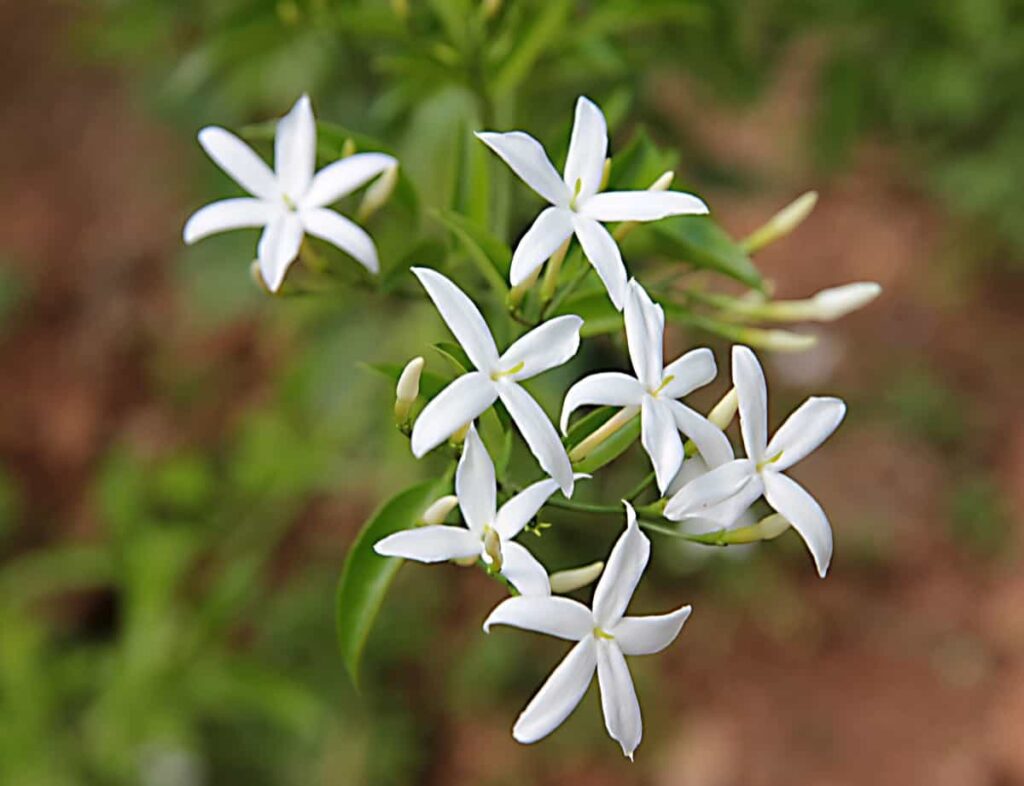
This plant thrives well in full sun but can also tolerate partial shade. It prefers well-drained soil and should be watered regularly during the growing season. Once established, Jasmine Sambac is drought tolerant. Jasmine Sambac plants should be given a light fertilizer monthly during the growing season to encourage blooming. After flowering, the plants can be pruned to control their size and shape.
Jasmine Grandiflorum
Jasmine grandiflorum, also known as Spanish Jasmine or royal Jasmine, is a species of Jasmine native to southwestern China. It is an evergreen vine or shrub reaching a height of 20–40 m (66–131 ft.). The leaves are opposite, simple oval-shaped with a pointed tip, 6–12 cm (2.4–4.7 in) long and 3–8 cm (1.2–3.1 in) broad. The flowers are white, with five petals fused at the base, and have a strong sweet fragrance. They bloom in the summer and continue until fall.
Jasmine grandiflorum is widely grown as an ornamental flower plant for its fragrant flowers throughout the tropics and subtropics, including in southern Europe, Egypt, Sudan, Pakistan, Bangladesh, India, Nepal, Sri Lanka, Vietnam, Laos, Cambodia, Thailand, Malaysia, Indonesia, Philippines, and Taiwan. In colder climates, it is grown under glass.
Jasmine polyanthum
Polyanthum Jasmine is a species of Jasmine native to China. It is an evergreen vine or shrub reaching a height of 10 m (33 ft). The leaves are opposite, simple, 6–12 cm (2.4–4.7 in) long and 2–6 cm (0.79–2.36 in) wide. The flowers are white, borne in axillary clusters of 3-5 blooms, each 5 cm across with five petals. The fruit is a blackberry 5 mm in diameter.
In case you missed it: 15 Best and Easiest Cut Flowers to Grow from Seed: Beautify Your Garden with These
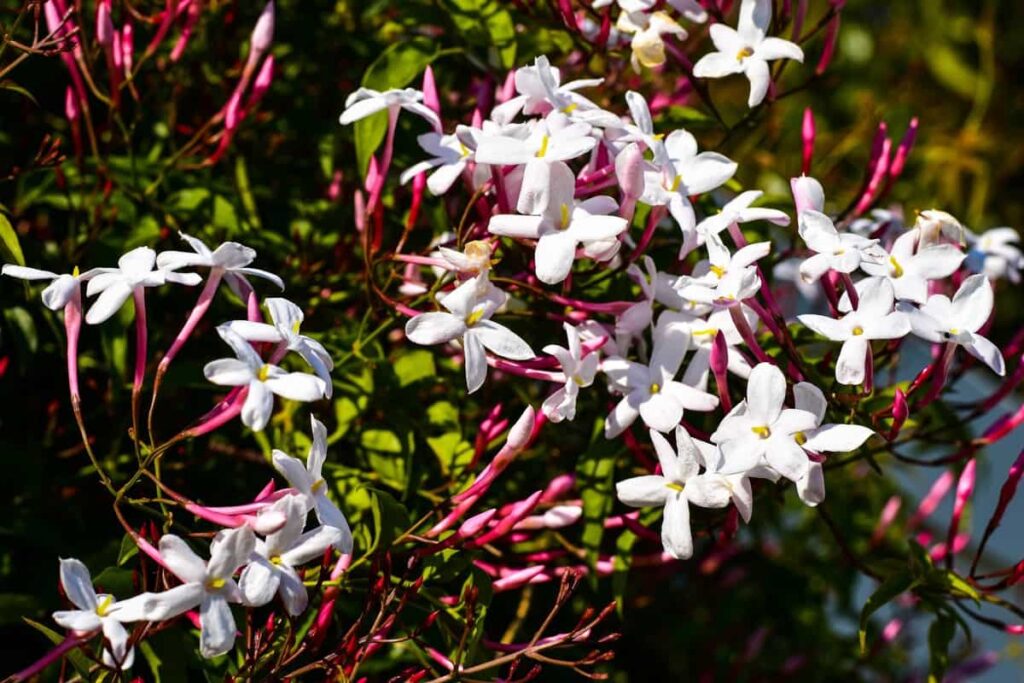
This species is often grown as an ornamental flower plant in temperate regions due to its strong, fragrant flowering in late winter or early spring. It can be trained as a climber on trellises, walls, or fences and can also be grown as a groundcover or trailing plants on banks or in hanging baskets.
Jasmine Officinale
There are many species of Jasmine, but Jasmine Officinale is perhaps the most well-known. It’s a vigorous twining vine that can reach 15 feet or more in length. The small, white flowers are intensely fragrant and bloom from late spring to early summer. Jasmine Officinale is hardy in USDA zones 7 to 10. Jasmine Officinale is relatively easy to grow. Jasmine plants prefer full sun but will tolerate partial shade, and it’s not particular about soil type as long as it’s well-drained.
Once established, Jasmine is quite drought tolerant. It would help if you watered regularly during the first growing season which helps the plant establish a deep root system; you can let the soil dry out somewhat between watering. Softwood cuttings usually propagate this Jasmine from late spring or early summer. The plant cuttings should be 4 to 6 inches long and taken from new growth that has yet to flower.
You need to dip the cut-end in rooting hormone, plant in a moist potting mix, and keep humid with regular misting until roots have developed (usually 4 to 6 weeks). Once rooted, transplant to individual pots filled with well-draining potting soil; water regularly and fertilize monthly throughout the growing season. In late fall or early winter, before new growth begins, prune Jasmine vines back by one-third to promote bushy growth.
How to grow Jasmine flowers
Jasmine is an excellent option if you’re looking for a fragrant flowering plant to add to your garden. Jasmine flowers have a sweet, strong scent that can fill your garden with fragrance. Here’s how to grow Jasmine flowers:
- Jasmine is a tropical plant that needs warm weather and bright sunlight to thrive. In cooler climates, you can grow Jasmine indoors near a sunny window.
- To propagate Jasmine, take stem cuttings from an existing plant and root them in water or moist soil.
- When planting Jasmine, choose a spot that gets full sun. Jasmine prefers well-drained soil.
- Water Jasmine plants regularly, keeping the soil moist but not soggy. Fertilize your Jasmine monthly during the growing season.
- Pruning is essential for keeping your Jasmine healthy and encouraging new growth. Prune back any dead or diseased stems, and trim any leggy growth.
Propagation and Planting of Jasmine flowers
Jasmine flowers are one of the most popular choices for fragrance in the home and garden. They have a strong, sweet scent that can fill a room or outdoor space with their heady perfume. In addition, Jasmine flowers are relatively easy to propagate and care for, making them an excellent choice for those new to gardening or looking for low-maintenance plants. When propagating Jasmine flowers, it is best to start with cuttings taken from an existing plant.
Cuttings should be taken from healthy, non-flowering stems and placed in a well-draining potting mix; water the cuttings well and place them in a bright, indirect light until new growth appears. Once new growth has begun, you can transplant the cutting into its pot or the ground. When planting Jasmine flowers, choose a location that receives full sunlight to partial shade and has well-drained soil.
Jasmine flowers are planted directly in the ground or containers. If planting in containers, ensure the container is large enough to accommodate the roots and has drainage holes to prevent overwatering. When planting Jasmine flowers, you should dig a hole two times wider than the size of the root ball. The hole should be just as deep as well. It is recommended to gently loose the roots before placing the plant in the hole and backfilling it with soil—water well immediately after planting and continue to water regularly during dry periods.
Care of Jasmine plants
Jasmine is an excellent option if you want a fragrant flower to add to your garden. These beautiful blooms have a sweet, intoxicating scent that is sure to please. Plus, they’re relatively easy to care for. Here are certain things you need to know about growing Jasmine flowers indoors, outdoors, or in pots. When choosing a Jasmine plant, there are wide different varieties. Some of the most popular include Arabian Jasmine (Jasminum sambac), Italian Jasmine (Jasminum humile), and Spanish Jasmine (Jasminum grandiflorum).
Once you’ve selected a plant, it’s time to get it in the ground. Jasmine prefers well-drained soil and full sun but can tolerate partial shade. When planting, space the plants about 3 feet apart, so they have room to grow. Once your plants are in the ground, water them regularly. For example, Jasmine is drought-tolerant but will produce more flowers if given consistent moisture.
Once the plants are established, you can reduce watering to once per week or so. In addition to watering, fertilize your Jasmine plants every few weeks during the growing season. Again, a balanced fertilizer will do the trick. Just be sure not to overdo it – too much fertilizer can harm the plants.
How to grow Jasmine indoors
Jasmine is a beautiful and fragrant flower that can be grown indoors with simple care. Here are some tips and ideas on how to grow Jasmine indoors:
- Pick a spot in your home with lots of bright, indirect sunlight. Jasmine flowers need at least six hours of sunlight each day to thrive.
- Jasmine prefers soil that is well-draining but moist. Use a potting mix designed for flowers, or mix your own using two parts perlite or vermiculite and one part peat moss.
- Water your Jasmine plant regularly, ensuring the soil stays moist but not water-logged. Allow the top inch of plant soil to dry out before watering again.
- Feed your Jasmine plant monthly using a balanced fertilizer designed for flowers. -Pruning isn’t necessary, but you can trim long or leggy stems to encourage fuller growth.
How to prune your Jasmine plants
Pruning is an essential part of caring for Jasmine plants. Pruning the plant helps to encourage new growth, gives a good framework and keeps the plant healthy. When pruning your Jasmine plant, it’s recommended to perform in early spring or late winter.. Here are some tips and techniques on how to prune your Jasmine plants:
- Start by removing any dead or dying branches. Cut these back to the main stem of the plant.
- Next, trim back any long or straggly branches. Cut these back to a point where they branch off the main stem.
- Finally, cut back any branches crossing or rubbing against each other. This will help to prevent damage and encourage new growth. When pruning your Jasmine plants, use sharp, clean shears. This will help to prevent damage to the plant and promote healing.
How to stake a Jasmine plant
Jasmine is a climbing plant that can grow over 10 feet tall. When grown outdoors, Jasmine needs some support to climb on. Staking is one way to provide support for your Jasmine plant. Here’s how to stake a Jasmine plant:
- Choose a location for your Jasmine plant that gets full sun or partial shade and has well-drained soil.
- Drive a stake into the ground next to your chosen location. The stake should be at least 2 feet taller than the height you want your Jasmine plant to reach.
- Tie the Jasmine plants to the stake using soft twine or strips of cloth. Be sure not to tie the plant too tightly, as this can damage the stem.
- Water your Jasmine plant regularly, especially during hot, dry weather.
- Once your Jasmine plant reaches the desired height, you can remove the stake.
In case you missed it: Seed Germination Chart in India: Duration and Temperature for Fruits, Vegetables, Flowers, and Herbs
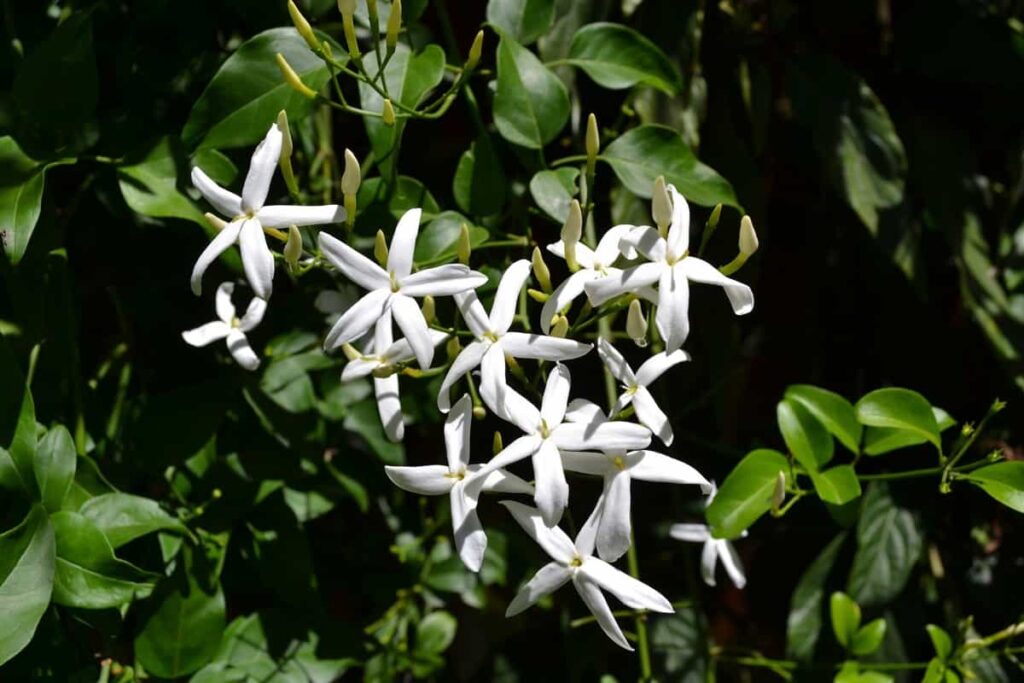
Common Jasmine plant pests and diseases
Jasmine plants are prone to several pests and diseases, many of which can be fatal if left untreated. Some of the most common Jasmine plant pests and diseases include:
Aphids
These pests are small sap-sucking insects that can cause extensive damage to Jasmine plants. Aphids infest the undersides of leaves and stems and can cause the plant to become stunted and deformed. In severe cases, aphid infestations can kill Jasmine plants. Spider mites are tiny spider-like creatures that feed on plant juices. Spider mite infestations typically result in the yellowing or bronzing of leaves and webbing between leaves and stems. If left untreated, spider mites can kill Jasmine plants.
Powdery mildew
This fungal disease that causes a white, powdery growth that usually forms on the surfaces of Jasmine leaves and stems. Powdery mildew can weaken and even kill Jasmine plants if left untreated. Overly wet or poorly drained soils cause root rot. Root rot causes the roots of Jasmine plants to decay and eventually die. This can lead to the death of the entire plant.
How to bring a Jasmine plant back to life
If your Jasmine plant is looking a little worse, don’t despair! You can bring it back to life with love and attention. Here’s what to do:
- Start by pruning away any dead or dying branches. This will help encourage new growth.
- Make sure your plant is getting enough sunlight. Jasmine plants need at least 6 to seven hours of direct sunlight per day.
- Water your plant regularly, ensuring the soil stays moist but not soggy.
- Feed your plant with a high-quality fertilizer formulated for Jasmine plants.
How to make Jasmine plant bushy
- Prune it regularly.
- Cut back the stems by a third of their length every few weeks. This will encourage the plant to produce new growth, making it fuller and bushier.
- In addition to pruning, fertilize your Jasmine plant every few months to promote healthy growth. You should use a balanced fertilizer that contains nitrogen, phosphorus, and potassium.
- Apply the fertilizer according to the manufacturer’s instructions.
- Make sure your Jasmine plant is getting enough light.
It should be in a spot with at least six hours of direct sunlight daily. If it’s not getting enough light, it won’t grow as full and bushy as it should.
In case you missed it: How to Grow Columbine Flowers: A Guide to Propagation, Planting, and Care
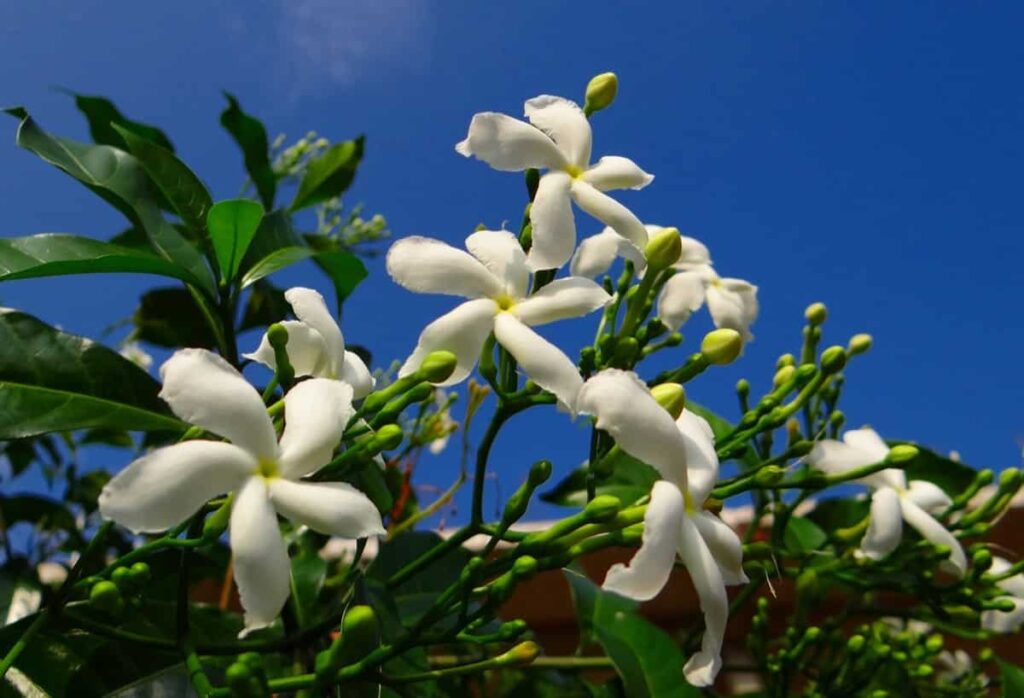
Homemade fertilizer for Jasmine plant
Jasmine is a popular plant in the home and is known for its beautiful flowers. While this plant does not require a lot of fertilizer, you should boost it with homemade fertilizer. This fertilizer can be made with things you may already have in your home, giving your Jasmine plant the nutrients it needs to thrive. To make this fertilizer, you will need
- 1 cup of coffee grounds
- 1 cup of Epsom salt
- 1 banana peel
- 1 eggshell
Mix all these ingredients and apply them to the soil around your Jasmine plant. You can do this once a month or as needed. This homemade fertilizer will give your plant the boost it needs to grow strong and healthy.
5 Tips for making your Jasmine bloom more
- Give your Jasmine room to grow. Jasmine is a climbing plant, so it needs space to spread out. If you want to grow Jasmine in a pot, make sure the pot is big enough for the roots to have room to grow. If you’re growing it in the ground, give it some support to climb on, like a trellis or fence.
- Plant it in well-draining soil. Jasmine likes its roots to be moist but not soggy. So plant it in soil that drains well and doesn’t stay soggy after a rainstorm.
- Give it full sun. Jasmine loves the sun and needs at least six hours of direct sunlight each day to bloom well. If you live in a hot climate, give it some afternoon shade to prevent the leaves from scorching by the sun.
- Fertilize regularly. Jasmine is a heavy feeder and needs regular fertilization to bloom well. Use a fertilizer made for blooming plants and follow the directions on the package for how often to fertilize.
- Prune regularly. To keep your Jasmine looking its best and encourage lots of blooms, prune it regularly. Trim off any dead or dying Jasmine stems, as well as any other stems that are crossing or rubbing against each other.
In case you missed it: How to Grow Rajnigandha (Tuberose): Soil, Propagation, Flowering Season, Planting, and Care
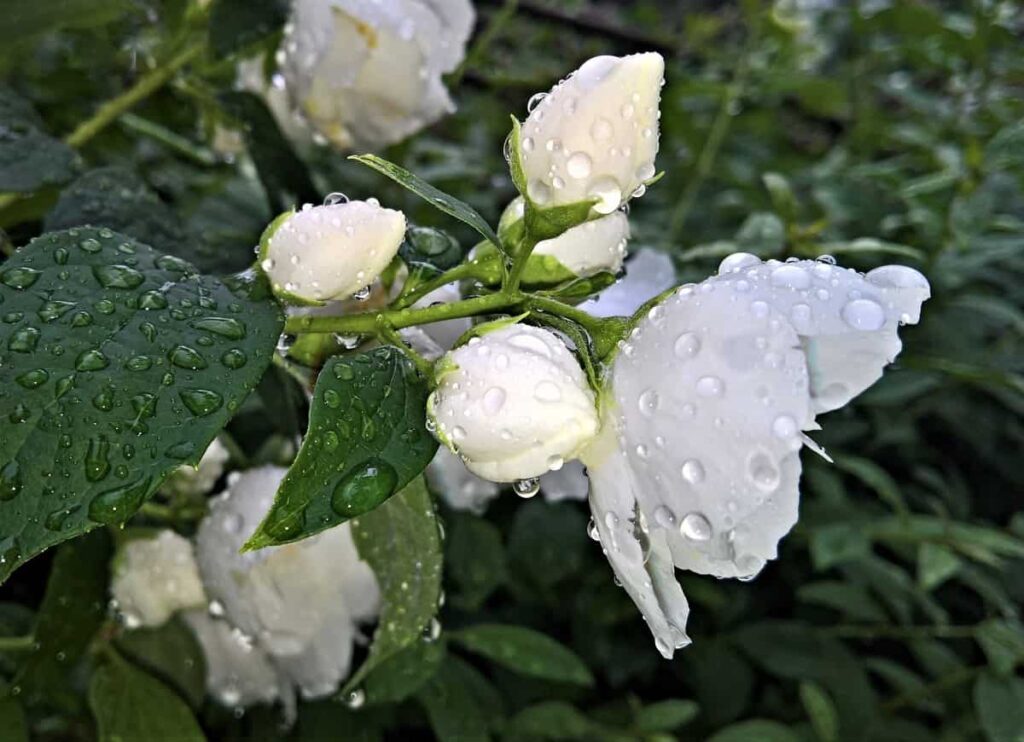
Reasons for Jasmine not flowering
- The Jasmine plant may need more sunlight. Therefore, you need to place it in a sunny location.
- The soil might be too dense and need to be loosened. Use a hand trowel to loosen the soil around the plant.
- The Jasmine plant may be rootbound, meaning the roots have filled the pot and need more space to grow. Again, repotting the plant in a larger pot will help with this issue.
- Jasmine plants must be regularly pruned to promote healthy growth and flowering. It would help if you used sharp pruning shears to cut back any overgrown or leggy branches.
- Ensure you are regularly watering the plant and giving it the right amount of water. Too much or too little water can cause problems for Jasmine plants.
Conclusion
The Jasmine flower is highly sought-after for its beautiful fragrance. If you plan to add a bit of fragrance to your garden, you should consider these top 4 Jasmine flowering plants. They are relatively easy to grow and care for, so you shouldn’t have trouble getting them to thrive. With patience, you’ll soon be enjoying the sweet smell of Jasmine in your garden.
In case you missed it: How to Grow Potato Plants Faster: Best Tips to Increase Flowering, Fruiting, and Yield
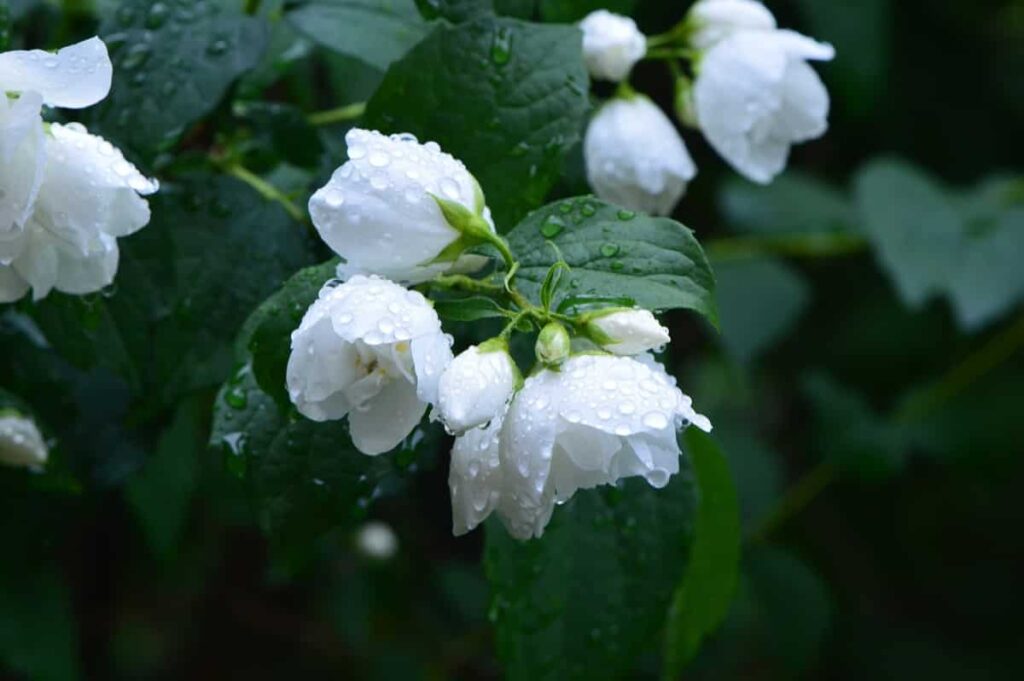
- Sheep Farming Business Plan for Beginners
- Aquaponic Farming at Home: A Step-By-Step Guide
- Profitable Village Farming Business Ideas in 2024
- High-Yield Aquaculture: Fast-Growing Fish for Farming
- Effective Fish Pond Construction Techniques for Beginners
- Irrigation and Water Management in Pineapple Farming
- Blossom to Harvest: Mastering Flowering and Pollination in Papaya Farming
- Pig Fattening Essentials: From Selection to Sale for Beginners
- Raising Wagyu Cattle: A Complete Guide for Premium Beef Production
- Soil Types and Their Water Holding Capacity
- Optimizing Irrigation Schedules for Coconut Groves for Enhanced Yield
- Espresso Your Garden: Coffee Grounds for Healthier Acid-Loving Plants
- The Best Soil Mix for Snake Plants: How to Mix Your Own Snake Plant Soil
- Green Thumb Success: Expert Tips for Cultivating Greenhouse Beans All Year Round
- Bloom All Year Round: The Ultimate Guide to Indoor Hyacinth Care
- Eco-Friendly Gardening: How to Make Liquid Fertilizer from Kitchen Waste
- Ultimate Guide to Grow Anise in Pots: Explore Seed Propagation to Harvesting
- Guide to Raising Chester White Pigs: Discover Breed Facts to Growth Management
- Mastering the Elegance: The Ultimate Guide to Weeping Cherry Tree Care, Planting, and Maintenance
- Ultimate Guide to Planting Garlic in Grow Bags: Growing Strategies for Beginners
- How to Fix Spider Plant Leaf-Related Problems: Natural and Organic Remedies
- 10 Reasons Why Your Tulsi Plant is Shedding Leaves: Home Remedies and Solutions
- Optimizing Growth and Yield: The Advantages of Palm Bunch Ash Fertilizer
- Utilizing Neem Oil Extract as a Natural Pesticide for Hydrangea
- From Soil to Harvest: Various Ways in Which Farmers Can Use AI Tools
- Steps to Encourage and Induce Citrus Flowers: A Comprehensive Guide
- How to Fix Snake Plant Leaf-Related Issues: Natural and Organic Remedies
- Transform Your Garden into a Fragrant Oasis with Raat Ki Rani (Night Blooming Jasmine)
- Discover the Ideal Chicken Breeds for Philippine Farms
- How to Create a Poultry Egg Farm Business Plan for Profits
- Grow Lemon Cucumbers Like a Pro: Insider Techniques for Bountiful Yields
- Ultimate Guide to Caring for Your Pink Princess Philodendron: Tips for Thriving Variegation
- Areca Nut Profit Per Acre: Calculating Yield and Cost of Cultivation
- How Kaveri Chicken is Becoming a More Profitable Breed in Indian Backyards
- Transform Your Barn: 9 Steps to Convert a Horse Stall into a Chicken Coop
- Exploring Suffolk Sheep Disadvantages with Limitations and Challenges
